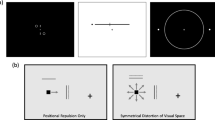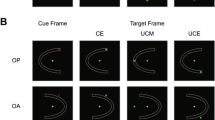Summary
Two discrimination experiments were run to investigate analog versus discrete properties of a shift of visual spatial attention. Central cuing was used in Experiment 1, whereas peripheral cuing was used in Experiment 2. Presentation of a probe stimulus between fixation and the target (Distance 1), opposite fixation from the target (Distance 3), or away from an imaginary line running from the target through fixation (Distance 2) permitted a fine-grained analysis of attention at those loci across target-probe delays. D-prime analyses in both experiments suggest that attention is shifted in a discrete manner between locations. Sensitivity to probes was generally greater when the probe was aligned with the target and fixation, with Distance 3 equal to Distance 1, than when it was away (at Distance 2). Analysis of sensitivity to targets across cue-probe delays suggests that attention was directed to the probe upon its appearance.
Similar content being viewed by others
References
Chastain, G. (1991). Is processing level set by the first pattern encountered during a covert visual attention shift? Unpublished manuscript.
Chastain, G. (1992). Is rapid performance improvement across short precue-target delays due to masking from peripheral precues?Acta Psychologica, 79,101–114.
Cheal, M., & Lyon, D. (1989). Attention effects on form discrimination at different eccentricities.Quarterly Journal of Experimental Psychology, 41A, 719–746.
Cheal, M., & Lyon, D. (1991). Central and peripheral precuing of forced-choice discrimination.Quarterly Journal of Experimental Psychology, 43A, 859–878.
Cherry, E. C. (1953). Some experiments upon the recognition of speech, with one and with two ears.Journal of the Acoustical Society of America, 25, 975–979.
Downing, C. J. (1988). Expectancy and visual-spatial attention: Effects on perceptual quality.Journal of Experimental Psychology: Human Perception and Performance, 14, 188–202.
Egly, R., & Homa, D. (1991). Reallocation of visual attention.Journal of Experimental Psychology: Human Perception and Performance, 17, 142–159.
Eriksen, C. W., & Murphy, T. D. (1987). Movement of attentional focus across the visual field: A critical look at the evidence.Perception & Psychophysics, 42, 299–305.
Hoffmann, J. E., Nelson, B., & Houck, M. R. (1983). The role of attentional resources in automatic detection.Cognitive Psychology, 15, 379–410.
Jonides, J. (1981). Voluntary versus automatic control over the mind's eye's movement. In J. B. Long & A. D. Baddeley (Eds.),Attention and performance IX (pp. 187–203). Hillsdale, NJ: Erlbaum.
Kahneman, D., & Henik, A. (1977). Effects of visual grouping on immediate recall and selectiva attention. In S. Dornic (Ed.),Attention and performance VI (pp. 307–332). Hillsdale, NJ: Erlbaum.
Kahneman, D., & Henik, A. (1981). Perceptual organization and attention. In M. Kubovy & J. Pomerantz (Eds.),Perceptual organization (pp. 181–211). Hillsdale, NJ: Erlbaum.
LaBerge, D. (1983). The spatial extent of attention to letters and words.Journal of Experimental Psychology: Human Perception and Performance, 9, 371–379.
LaBerge, D., & Brown, V. (1986). Variations in size of the visual field in which targets are presented: An attentional range effect.Perception & Psychophysics, 40, 188–200.
Muller, H. J., & Findlay, J. M. (1987). Sensitivity and criterion effects in the spatial cuing of visual attention.Perception & Psychophysics, 42, 383–399.
Posner, M. I., Snyder, R. R., & Davidson, D. J. (1980). Attention and the detection of signals.Journal of Experimental Psychology: General, 109, 160–174.
Prinzmetal, W. (1981). Principles of feature integration in visual perception.Perception & Psychophysics, 30, 330–340.
Remington, R., & Pierce, L. (1984). Moving attention: Evidence for time-invariant shifts of visual selective attention.Perception & Psychophysics, 35, 393–399.
Sagi, D., & Julesz, B. (1986). Fast noninertial shifts of attention.Spatial Vision, 1, 141–149.
Shaw, M. L. (1984). Division of attention among spatial locations: A fundamental difference between detection of letters and detection of luminance increments. In H. Bouma & D. G. Bouwhuis (Eds.),Attention and performance X(pp. 109–121). Hillsdale, NJ: Erlbaum.
Shepard R. N.& Cooper L. A. (1982).Mental images and their transformations. Cambridge, MA: MIT Press.
Shepard, R. N., & Metzler, J. (1971). Mental rotation of three dimensional objects.Science, 171, 701–703.
Shepherd, M., & Muller, H. J. (1989). Movement versus focusing of visual attention.Perception & Psychophysics, 46, 146–154.
Shulman, G. L., Remington, R. W., & McLean, J. P. (1979). Moving attention through visual space.Journal of Experimental Psychology: Human Perception and Performance, 5, 522–526.
Springer, S. P., & Deutsch, G. (1981).Left brain, right brain. San Francisco: W. H. Freeman.
Treisman, A., & Gormican, S. (1988). Feature analysis in early vision: Evidence from search asymmetries.Psychological Research, 95, 15–48.
Treisman, A., & Schmidt, H. (1982). Illusory conjunctions in the perception of objects.Cognitive Psychology, 14. 107–141.
Tsal, Y. (1983). Movements of attention across the visual field.Journal of Experimental Psychology: Human Perception and Performance, 9, 523–530.
Tsal, Y. (1989). Do illusory conjunctions support the feature integration theory? A critical review.Journal of Experimental Psychology: Human Perception and Performance, 15, 394–400.
Van der Heijden, A. H. C., Wolters, G., & Enkeling, M. (1989). The effects of advance location cuing on latencies in a single-letter recognition task.Psychological Research, 50, 94–102.
Wetherill, G. B., & Levitt, H. (1965). Sequential estimation of points on a psychometric function.British Journal of Mathematical and Statistical Psychology, 18, 1–10.
Yantis, S. (1988). On analog movements of visual attention.Perception & Psychophysics, 43, 203–206.
Author information
Authors and Affiliations
Additional information
This research was supported by a grant from the National Science Foundation (BNS87-20421).
Rights and permissions
About this article
Cite this article
Chastain, G. Analog versus discrete shifts of attention across the visual field. Psychol. Res 54, 175–181 (1992). https://doi.org/10.1007/BF00922096
Received:
Accepted:
Issue Date:
DOI: https://doi.org/10.1007/BF00922096




